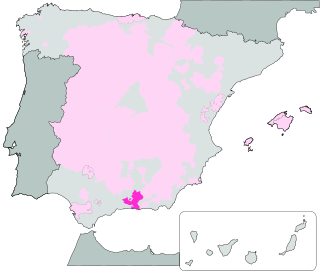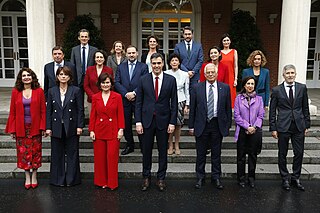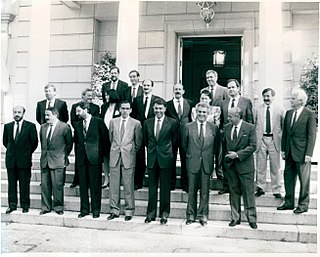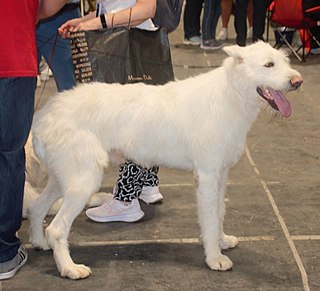
Laderas del Genil is a Spanish geographical indication for Vino de la Tierra wines located in the autonomous region of Andalusia. Vino de la Tierra is one step below the mainstream Denominación de Origen indication on the Spanish wine quality ladder.

The third government of Adolfo Suárez was formed on 6 April 1979, following the latter's election as Prime Minister of Spain by the Congress of Deputies on 30 March and his swearing-in on 2 April, as a result of the Union of the Democratic Centre (UCD) emerging as the largest parliamentary force at the 1979 Spanish general election. It succeeded the second Suárez government and was the Government of Spain from 6 April 1979 to 27 February 1981, a total of 693 days, or 1 year, 10 months and 21 days.

The government of Leopoldo Calvo-Sotelo was formed on 27 February 1981, following the latter's election as Prime Minister of Spain by the Congress of Deputies on 25 February and his swearing-in on 26 February, as a result of Adolfo Suárez's resignation from the post on 29 January 1981. It succeeded the third Suárez government and was the Government of Spain from 27 February 1981 to 3 December 1982, a total of 644 days, or 1 year, 9 months and 6 days.

The first government of Pedro Sánchez was formed on 7 June 2018, following the latter's election as Prime Minister of Spain by the Congress of Deputies on 1 June and his swearing-in on 2 June, as a result of the success of a motion of no confidence against Mariano Rajoy. It succeeded the second Rajoy government and was the Government of Spain from 7 June 2018 to 13 January 2020, a total of 585 days, or 1 year, 7 months and 6 days.

Jaime Lissavetzky Díez is a Spanish chemist and politician. Secretary of State for Sport (2004–2011) and regional minister of Education of the Government of the Community of Madrid. He was member of the 1st, 2nd, 3rd, 4th and 5th terms of the Assembly of Madrid, as well as member of the 8th Congress of Deputies and city councillor in the City Council of Madrid.
The National Environmental Award was an annual honor given by Spain's Ministry of Environment from 1986 to 2009. Several prizes were awarded, some of them bearing the names of distinguished naturalists such as Félix Rodríguez de la Fuente and Lucas Mallada. In 2009, its last year, each of the two awardees was endowed with 22,000 euros.

The Secretary of State for Education (SEE) is the second highest-ranking official within the Ministry of Education of Spain. It is a political appointment made by the Monarch on the advice of the minister in charge of the ministerial department.
The National Dance Award of Spain is an annual prize awarded by the Ministry of Culture since 1988 and regulated by the Royal Decree of 1995, along with the rest of the country's National Awards. It is granted by a jury and, since 2000, in two categories: Creation and Performance. Each confers a monetary prize of €30,000.
Francisco Gómez de Llano (1896–1970) was a Spanish politician and diplomat. In Francoist Spain, he served as Minister of Finance (1951–1957) and as Ambassador to the Holy See (1957–1962).

The first government of José Luis Rodríguez Zapatero was formed on 18 April 2004, following the latter's election as Prime Minister of Spain by the Congress of Deputies on 16 April and his swearing-in on 17 April, as a result of the Spanish Socialist Workers' Party (PSOE) emerging as the largest parliamentary force at the 2004 Spanish general election. It succeeded the second Aznar government and was the Government of Spain from 18 April 2004 to 14 April 2008, a total of 1,457 days, or 3 years, 11 months and 27 days.

The second government of José Luis Rodríguez Zapatero was formed on 14 April 2008, following the latter's election as Prime Minister of Spain by the Congress of Deputies on 11 April and his swearing-in on 12 April, as a result of the Spanish Socialist Workers' Party (PSOE) emerging as the largest parliamentary force at the 2008 Spanish general election. It succeeded the first Zapatero government and was the Government of Spain from 14 April 2008 to 22 December 2011, a total of 1,347 days, or 3 years, 8 months and 8 days.

The first government of Mariano Rajoy was formed on 22 December 2011, following the latter's election as Prime Minister of Spain by the Congress of Deputies on 20 December and his swearing-in on 21 December, as a result of the People's Party (PP) emerging as the largest parliamentary force at the 2011 Spanish general election. It succeeded the second Zapatero government and was the Government of Spain from 22 December 2011 to 4 November 2016, a total of 1,779 days, or 4 years, 10 months and 13 days.

The second government of Mariano Rajoy was formed on 4 November 2016, following the latter's election as Prime Minister of Spain by the Congress of Deputies on 29 October and his swearing-in on 31 October, as a result of the People's Party (PP) emerging as the largest parliamentary force at the 2016 Spanish general election. It succeeded the first Rajoy government and was the Government of Spain from 4 November 2016 to 7 June 2018, a total of 580 days, or 1 year, 7 months and 3 days.

The first government of José María Aznar was formed on 6 May 1996, following the latter's election as Prime Minister of Spain by the Congress of Deputies on 4 May and his swearing-in on 5 May, as a result of the People's Party (PP) emerging as the largest parliamentary force at the 1996 Spanish general election. It succeeded the fourth González government and was the Government of Spain from 6 May 1996 to 28 April 2000, a total of 1,453 days, or 3 years, 11 months and 22 days.

The first government of Felipe González was formed on 3 December 1982, following the latter's election as Prime Minister of Spain by the Congress of Deputies on 1 December and his swearing-in on 2 December, as a result of the Spanish Socialist Workers' Party (PSOE) emerging as the largest parliamentary force at the 1982 Spanish general election. It succeeded the Calvo-Sotelo government and was the Government of Spain from 3 December 1982 to 26 July 1986, a total of 1,331 days, or 3 years, 7 months and 23 days.

The second government of Felipe González was formed on 26 July 1986, following the latter's election as Prime Minister of Spain by the Congress of Deputies on 23 July and his swearing-in on 24 July, as a result of the Spanish Socialist Workers' Party (PSOE) emerging as the largest parliamentary force at the 1986 Spanish general election. It succeeded the first González government and was the Government of Spain from 26 July 1986 to 7 December 1989, a total of 1,230 days, or 3 years, 4 months and 11 days.

The third government of Felipe González was formed on 7 December 1989, following the latter's election as Prime Minister of Spain by the Congress of Deputies on 5 December and his swearing-in on 6 December, as a result of the Spanish Socialist Workers' Party (PSOE) emerging as the largest parliamentary force at the 1989 Spanish general election. It succeeded the second González government and was the Government of Spain from 7 December 1989 to 14 July 1993, a total of 1,315 days, or 3 years, 7 months and 7 days.

The fourth government of Felipe González was formed on 14 July 1993, following the latter's election as Prime Minister of Spain by the Congress of Deputies on 9 July and his swearing-in on 13 July, as a result of the Spanish Socialist Workers' Party (PSOE) emerging as the largest parliamentary force at the 1993 Spanish general election. It succeeded the third González government and was the Government of Spain from 14 July 1993 to 6 May 1996, a total of 1,027 days, or 2 years, 9 months and 22 days.

The second government of Pedro Sánchez was formed on 13 January 2020, following the latter's election as Prime Minister of Spain by the Congress of Deputies on 7 January and his swearing-in on 8 January, as a result of the Spanish Socialist Workers' Party (PSOE) emerging as the largest parliamentary force at the November 2019 general election. It succeeded the first Sánchez government and was the Government of Spain from 13 January 2020 to 21 November 2023, a total of 1,408 days, or 3 years, 10 months and 8 days.

The Valdueza or Perro Montero Valdueza is a modern Spanish breed of large pack-hound. It results from selective breeding, principally of large rough-haired Podenco Andaluz dogs with lightweight examples of the Mastín Extremeño; some Griffon Vendéen blood was later added. Breeding began in the 1940s; in 2020 the Valdueza was officially recognised by the Ministerio de Agricultura, Pesca y Alimentación, the Spanish ministry of agriculture, and was added to the list of indigenous Spanish breeds. It is not recognised by the Fédération Cynologique Internationale.

















